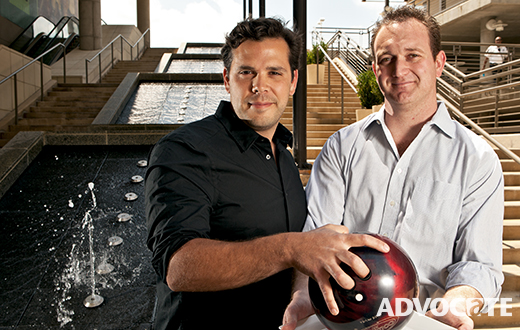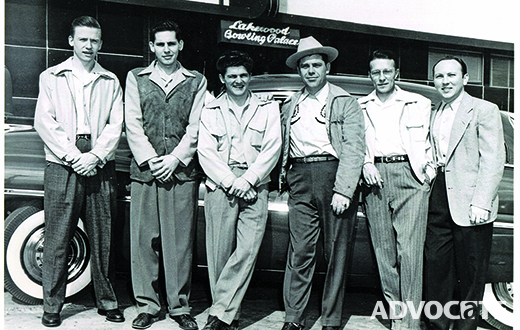Bowling keeps on rolling 70 years after its golden era

Kyle Noonan and Jeff Sepkowitz plan to open Bowl & Barrel, the city’s first new bowling alley in decades, this fall. Photo by Danny Fulgencio
The last of our neighborhood bowling alleys, Jupiter Lanes, closed two years ago, even though its owner had just spent $2 million renovating it. The popularity of bowling has dwindled in the past several decades, but a new wave of upscale bowling centers is setting trends.
The first new bowling alley Dallas has seen in decades is set to open in the Shops at Park Lane this fall. Two Lakewood-based entrepreneurs, Kyle Noonan and Josh Sepkowitz, are planning the center, Bowl & Barrel, which will offer specialty beers and gourmet pub grub, along with plush banquettes at the lanes’ ends. The wildly trendy Brooklyn Bowl in New York City inspired their business idea.
Noonan and Sepkowitz, who were SMU fraternity brothers, knew they eventually wanted to go into business together. Noonan had a 12-year career with Pappas Brothers restaurants, and Sepkowitz has a background in investment banking and real estate.
“We started looking at the major trend-setting cities — New York, Chicago, L.A. — and we saw this undercurrent that people wanted to go bowling,” Noonan says. “And it’s people you wouldn’t necessarily associate with your typical bowler.”
After a visit to Brooklyn Bowl about two years ago, they hired a consultant to determine whether such a business would work in Dallas. The answer, overwhelmingly, was “yes.” So they quit their jobs about a year ago and have been working on their upstart fulltime since then.
It took a year for Noonan and Sepkowitz to find the right location for their lanes.
“That’s why there’s not bowling in the city, because it’s hard to find the right building,” Noonan says.
Their space at Park Lane comprises 15,000 square feet. It will have 15 lanes, a 3,000-square-foot restaurant and bar, and plenty of parking.
A couple of other bowling lanes have been proposed in the area recently. One was announced for the former Copper Tank Brewery in Deep Ellum in 2010. And another was announced for Lower Greenville, in the former Lucky’s Roadhouse space. That idea, from Barcadia owner Brooke Humphries, was shot down by the City Plan Commission. The building’s owners sued the city over the building’s zoning, and that case is still in litigation.
So it seems Bowl & Barrel will be the first bowling alley of its kind in the city. Noonan and Sepkowitz have an advantage, they think, because they’re not renovating. Bowl & Barrel will go into a big empty retail box. It takes AMF about six months to install lanes, and they expect restaurant construction to take about that long, too.
“We want to get away from the old, tired bowling alley — the dingy, stale-smoke bowling alley — and make it a very comfortable, sophisticated, upscale place,” Noonan says.
It is a place, they say, that their wives would want to go for a ladies night out. It’s a place to socialize and meet new people.
“If the three of us went bowling together,” Noonan says, “we could walk out with six new friends.”
Where we used to bowl
In the early 1940s, bowling was so popular that the daily newspaper carried league scores as well as a weekly bowling column, “On and Off Lanes,” which reported local bowling news. Rolling a perfect 300 game in league play was enough to land a mention on the Associated Press newswire. Practically every neighborhood company had a bowling league, including the Lakewood Theater, WRR and Sears & Roebuck. There were also ladies leagues, including one for housewives. In 1943, 100 teams competed in a citywide bowling tournament at Lakewood Lanes on Oram.
By the late 1960s, however, bowling leagues were mentioned less frequently in the local paper, and Lakewood Lanes, in the building that now houses Teeter’s Faucet Parts, is mentioned only in retrospectives after 1965.
Bowling hall-of-famer Bill Lillard rolled his first ball at Lakewood Lanes, against his mother’s wishes, when he was a student at J.L. Long. He remembers that the owner, Sid Henry, who built the lanes in 1941, seemed unhappy in the bowling business.
“There was no automation. You had to have pin boys,” Lillard says. “And it was hard to get pin boys, so Mr. Henry would be in the back setting pins.”
Lillard says he set pins for 4 cents a game on Friday nights, and then he would spend all his earnings on bowling every Saturday. Lakewood Lanes was updated in 1950 with “electric semiautomatic pin setters,” according to news reports.
Lillard went on to bowl for the Budweiser team in St. Louis with Don Carter, and he was a charter member of the Professional Bowlers Association. In the early 1960s, he left team bowling and became one of the top individual bowlers in the nation. In 1968, Lillard moved with his family to Houston, where he still lives, and started five bowling centers there. Two are still in business.
“We’ve had very good success with our bowling centers,” Lillard says. “Our business is based on leagues, and people nowadays will not sign up to bowl 35 weeks out of the year. Participation is down all over the country, and it’s hard to get people to sign up.”

The M.O. Rush Automotive bowling team poses in front of Lakewood Lanes before their trip to a tournament in Atlantic City, March 1949. From left to right: Bill Lillard, Sonny Loy, Lynn Carter, M.O. Rush, Buddy Behrends and Don McClure. Photo courtesy of Bill Lillard
The transition in popularity from team bowling to individual bowling started in 1958, with the creation of the PBA, Lillard says. The PBA won over TV audiences, which was its goal, but it resulted in a loss of interest in team bowling, he says. That’s one factor in the decline of bowling in general, he says.
Noonan and Sepkowitz found that league bowling often deters the casual bowler. “Leagues were taking up all the peak times to bowl, and you could never get a lane,” Sepkowitz says.
The business plan for Bowl & Barrel is not based on league bowling. The center will host leagues on weeknights, and they are expected to carry about the same level of seriousness as league kickball, which hit a popularity peak a few years back. Weekends at Bowl & Barrel will be reserved for individual bowlers who want to drink good beer and have a nice dinner.
“It’s like bowling for non-bowlers,” Noonan says.






